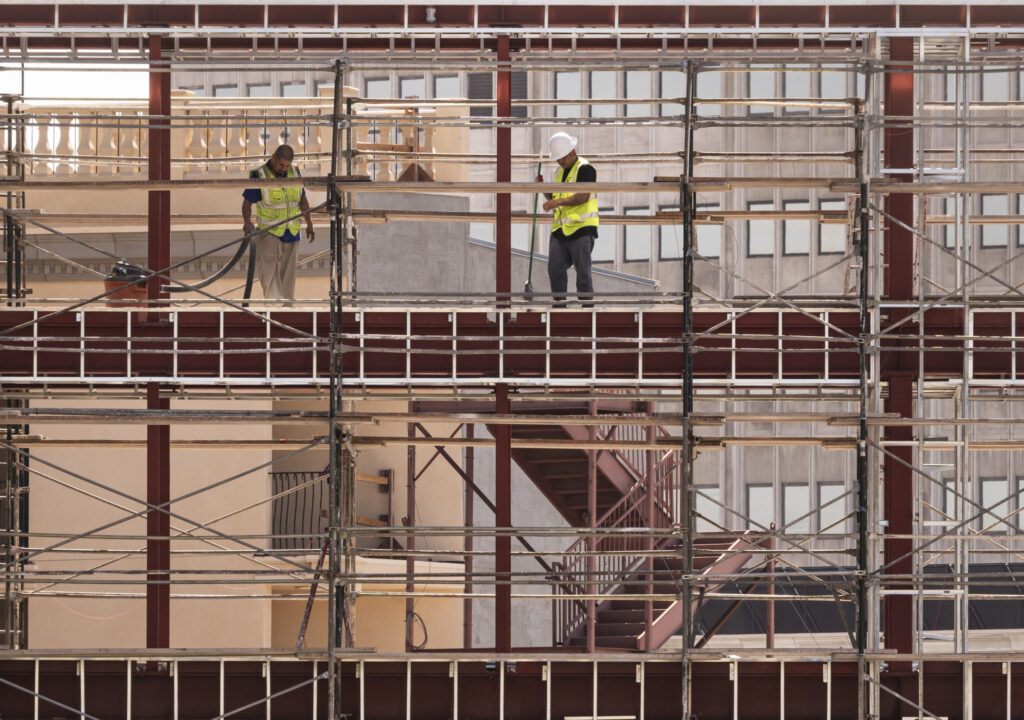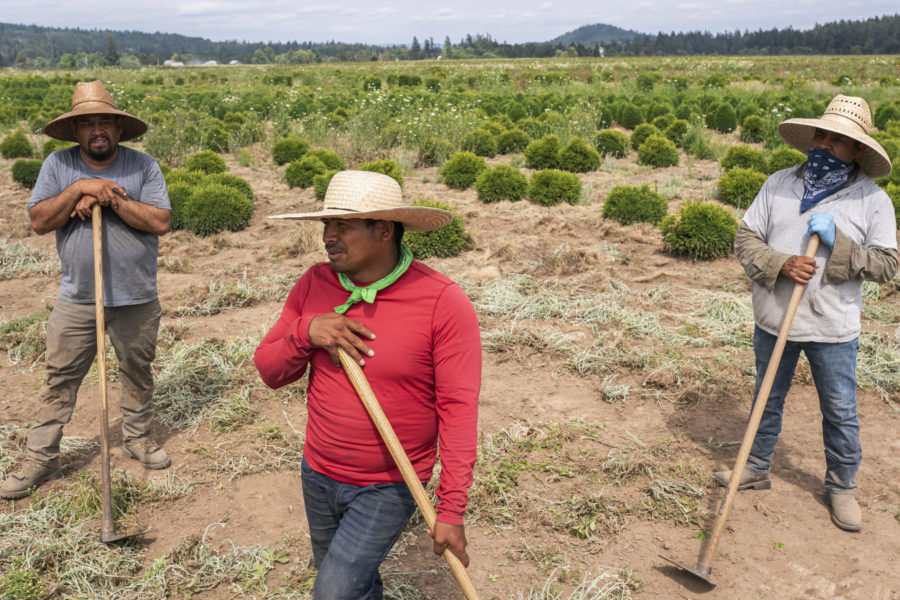When an extraordinary heat wave hit the Pacific Northwest in June 2021, with temperatures soaring to a record 116 degrees in Portland, it sent a hard-to-ignore message that extreme heat has become an increasing danger — not just in Arizona and Texas, but in northern states, too.
As a result of that heat wave, more than 100 people died in Oregon, and one issue that was repeatedly discussed afterwards was the way extreme heat endangers older Americans and those who live at home without air conditioning. But there was another serious danger that wasn’t discussed nearly enough: High heat can be a big problem for the nation’s workers, not just farmworkers and construction workers, but delivery workers, utility workers, landscaping workers, and warehouse workers.
A study done last summer by Public Citizen, a research and advocacy group founded by Ralph Nader, estimated that extreme heat contributes to between 600 and 2,000 worker fatalities each year in the United States. Those numbers are likely to grow worse because climate experts predict that the number of days with unsafe heat conditions will double between now and 2050. As global warming worsens, the world will see more intense droughts, longer heat waves, more severe storms, rising sea levels, melting glaciers, and more difficult conditions for many workers — especially for outdoor workers like agricultural workers, delivery drivers, and construction workers.Intense heat can cause, among other things, heat stroke, cardiac events, and kidney failure. “This is a very serious and growing problem with more high heat days this year and the highest temperatures on record in many states,” says Ellen Widess, former chief of the California Division of Occupational Safety and Health and senior advisor to the University of California Merced’s Community and Labor Center. “We’re also seeing extreme heat in parts of the country that have rarely or never experienced high heat.”
Amid growing worries about heat, many occupational safety experts criticize the federal government for not issuing an occupational heat stress rule or standard that would protect workers from extreme heat, perhaps by requiring shade, water, and rest breaks whenever temperatures hit a certain level.
Many occupational safety experts also fault the media, saying news organizations have done too few stories about this threat to workers and done too little to educate the public about it. “The problem is huge, and the media sometimes they just don’t get the breadth of it. There’s a failure to see how it’s affecting many workers,” says Juley Fulcher, a worker health and safety advocate at Public Citizen. “The media is there the moment there is a heat wave. That’s when they show up. The problem is the media isn’t there any other time to cover this problem.”
Some safety experts say one reason the media — and the nation — pay so little attention to the threat that high heat poses for workers is that the hardest hit occupational group is farmworkers, a group that society often overlooks, partly because it’s largely comprised of low-paid immigrants.
Extreme heat often sneaks up on workers and can be deadly. A handful of media organizations have taken a close look at the problem.
Sebastian Perez, 38, collapsed and died during the 2021 heat wave in Oregon. An in-depth article in Rolling Stone described how he was working alone in a field in the Willamette Valley, moving 30-pound irrigation pipes to help ensure that young trees survived the heat wave. Temperatures rose to well over 100 degrees that afternoon, and when Perez’s co-workers began a search for him after he didn’t answer his phone, they found him slumped on the ground, barely breathing. He died before the ambulance arrived.
With the mercury heading toward 88, firefighter Yaroslav “Yaro” Katkov, a 28-year-old immigrant from Ukraine, was doing a standard training exercise, hiking a 1.45-mile loop in a mountainous area halfway between Los Angeles and San Diego, NPR reported. Even though Katkov was lagging badly behind the others, the fire captain ordered the squad to repeat the loop. Katkov soon collapsed and was airlifted to a hospital. He died the next day from “heat illness,” according to NPR.
On a July day that hit 96 degrees, Karl Simmons, a 30-year-old African-American Navy veteran, collapsed while working in Fort Worth to patch the turf of a soccer field. A passerby saw Simmons sprawled on the ground, facedown, and alerted his co-workers. He was rushed to a hospital but died from heat stroke. According to an article by Columbia Journalism Investigations and the Texas Newsroom, “His body temperature registered 107.1 degrees — high enough to shut down internal organs such as the heart and kidneys.”
“One thing that is so important to get across is the craziness of this — this is all preventable,” says Julia Shipley, a former investigative reporting fellow at Columbia Journalism School who was part of the team that did a year-long project about extreme heat and workers that looked into Simmons’ and Katkov’s deaths. “These workers arrive at their job in the morning. They’re healthy and functioning people. They kiss their wife or husband good-bye. They wave to their kids going off to school. … They’re human beings like you and me, and they’re dead by the end of the day.It’s crazy to take a human being who’s healthy, and through this process of … rising core temperatures and bodily efforts and the lack of water and the lack of shade and the lack of breaks and the lack of attention, they suddenly die. It’s so insidious. When a worker is crushed by a bulldozer, you can see that. This is much more surreptitious, yet all the more urgent because of that.”
This increased discussion about heat’s effects on U.S. workers comes at the same time a huge controversy erupted in Qatar about the deaths of migrant workers who constructed the stadiums, roads, hotels, and apartment buildings for the World Cup competition. The Guardian reported that hundreds of migrant construction workers died annually from heat stress in recent years in Qatar as they worked in heat as high as 113 degrees. Indeed as temperatures rise across the globe, there are more reports and studies about workers dying and suffering from heat in country after country, including China, Singapore, and Spain.
Job safety experts emphasize that high temperatures can endanger not just outdoor workers, but also indoor workers, such as bakery workers and workers in commercial kitchens. Perhaps the most publicized example came a little over a decade ago when The Morning Call in Allentown did an exposé about an Amazon fulfillment center in Pennsylvania’s Lehigh Valley. “During summer heat waves, Amazon arranged to have paramedics parked in ambulances outside, ready to treat any workers who dehydrated or suffered other forms of heat stress,” the paper reported. “Those who couldn’t quickly cool off and return to work were sent home or taken out in stretchers and wheelchairs and transported to area hospitals.” At one point, the temperature-humidity index inside the warehouse reached 114 degrees.

After that exposé, Amazon added more air conditioning in its warehouses, but many Amazon workers still complain of heat problems. This past August, workers at an Amazon air freight warehouse in San Bernardino, California, walked off the job to demand higher pay and better safety measures against the heat. The Washington Post wrote that local temperatures “often reached above 100 degrees this summer, causing heat-related illness in particular for workers who are outdoors loading and unloading planes.”
According to the Bureau of Labor Statistics, about 30 workers die in the U.S. each year directly from the heat. But many experts say the official numbers significantly understate the total and the overall problem.
David Michaels, who was assistant secretary of labor for the Occupational Safety and Health Administration under President Obama, said heat fatalities are undercounted because the authorities count deaths as caused by heat only when the victim has been taken to a hospital and their body temperature is measured. “It can be very difficult to attribute a death to heat,” says Michaels, an epidemiologist now teaching at the George Washington University School of Public Health. He notes that it’s easy to blame other causes, such as heart attacks or respiratory conditions. “Extreme heat causes the body to become so hot that it stops functioning,” Michaels adds.
Public Citizen’s report said that “environmental heat is likely responsible for 170,000 work-related injuries every year, and possibly many more.” For instance, high heat can make workers dizzy or faint, and that can cause workers who operate machines to make mistakes that can seriously injure them or their coworkers.
Widess says the media could do far more to educate workers, employers, and the public about extreme heat. “It would be good to cover the scientific evidence to make it more of an acknowledged problem, not a random thing — not a high heat day here and there, but a kind of relentless or ongoing problem,” she says. “Better media coverage could pressure employers to take the necessary steps to help workers. Better media coverage could put more pressure on policymakers to adopt rules or standards, to act in the void of federal inaction.”
California, Oregon, Washington, and Minnesota are among the only states that have adopted heat standards requiring employers to take specific steps in hot weather — such as giving periodic breaks to cool off. (Colorado recently created one specifically to protect farm workers.) Worker advocates like Widess hope that other states will soon adopt such standards.
Public Citizen’s Fulcher says the media could play a valuable role in reducing heat deaths and illnesses. “The media should really start focusing stories on this in the spring or early in the summer,” she says. “You want to do a lot of advance awareness before, rather than after, raising awareness among the general public.”
The occasional stories about workers dying from heat stress indicate that employee and employer alike often paid scant attention to heat’s potential dangers. A Los Angeles area postal worker, 63, Peggy Frank, died after temperatures in her mail truck climbed to 117 degrees. On a day when the heat index hit 90, a 47-year-old laborer died on his third day on the job, doing roofing work at a high school in Jefferson City, Missouri. A day after he turned 24, Esteban Chavez Jr., a UPS driver, passed out in his truck and died after finishing the last delivery on his route in Pasadena, California. The temperature was in the upper 90s. In an area where one wouldn’t expect heat deaths — upstate New York — Tim Barber, 35, died on the second day on his construction job. He was working in 95-degree heat on a bridge project over the Genesee River near Rochester. (A disproportionate number of workers who die are new workers, not acclimated to working in high heat.)
If workers and employers are educated to recognize the symptoms of heat exhaustion — which precedes heat stroke — that could help save workers’ lives. Symptoms of heat exhaustion include heavy sweating, dizziness, rapid pulse, muscle cramps, fatigue, headaches, and goose bumps. Heat stroke’s symptoms include an altered mental state, vomiting, nausea, rapid breathing, and very rapid heart rate.
There are many worthwhile stories to be done about extreme heat. One would explore why such a disproportionate number of workers who die from heat are Black or brown, like Perez and Simmons. Another focus could be why the federal government has never adopted a heat standard, even though the National Institute for Occupational Safety and Health first called for such heat-stress rules in 1972. After previous administrations failed to act to create a standard, the Biden administration announced in September 2021 a plan to draft workplace heat regulations, but the process, which involves several rounds of soliciting public comment, could take five years.
Some occupational safety experts argue that the media should examine what they say is insufficient enforcement to protect workers from heat. Several say that federal OSHA and Cal/OSHA are badly understaffed and need more inspectors to investigate heat-induced deaths and illnesses. Another problem: Even when OSHA levies fines against an employer for failing to prevent a worker’s death, judges sometimes overturn those fines, saying employers shouldn’t be punished when there aren’t specific federal heat regulations stating what an employer’s obligations are in such situations.
David Nickerson, a data journalist with the Bay Area News Group in California who worked on the Columbia investigation team with Shipley, has done extensive reporting on extreme heat. He suggests that journalists do more accountability stories that examine whether government safety officials have followed up on ensuring safety improvements after a workers’ heat death and whether companies where a worker died have taken the promised steps to prevent future heat deaths.
Speaking about Hellas Construction, the company that employed Simmons, Nickerson says, “It was remarkable that what happened with Hellas is a worker died from heat, and then OSHA inspected the company and there was an agreement to stop this from happening again. But the company did not fully follow up. When a worker named Pedro Martinez Jr. came in a year later, on his third day at work again there was no shade and again there was limited water, and that day another worker died.”
Another focus for reporters could be the extensive industry opposition to creating federal heat regulations, whether from agricultural employers or warehouse companies. For instance, the National Cotton Council strongly opposes Biden’s plan to adopt a heat standard, saying, “Agriculture is not an industry that can be successfully regimented as some other industries have been.”
Michelle Tigchelaar, co-author of a major report on heat risks for farmworkers, says more coverage is needed about extreme heat’s threat to farmworkers. Not only do they often work in searing temperatures without any shade, she says, but “these workers have little agency to set their own schedule or pace when it’s extremely hot because they’re paid by the piece,” and that creates considerable pressure to rush and work long hours. Moreover, Tigchelaar says, many farmworkers are scared to speak up about dangers like high heat because they’re on H-2A temporary visas and can be deported if their employer fires them.
“Another problem,” according to Tigchelaar, “is the farm owners who need to provide housing, and it’s often not equipped with air conditioning or other ways people can cool off at night. That leaves workers more vulnerable to high heat the next day.”
Safety experts say it would be helpful if the media did more stories about model employers or programs that do a good job protecting workers from heat. Some farms and construction companies begin their workday at 4 a.m. or so and try to end work around noon, sparing workers from toiling in the hottest afternoon hours.
Julia Shipley, the reporting fellow at Columbia Journalism School, sees one thing as key to writing stories about heat’s dangers and heat deaths: You have to take a deep dive and describe the whole person, she says. Shipley and her team wrote about Cruz Urias-Beltran, a 52-year-old immigrant from Mexico who collapsed and died while working on a Nebraska cornfield on a 91-degree day in July. “His core body temperature was 108 degrees — hot enough for the brain, liver and kidneys to shut down,” they wrote. Shipley noted that Urias-Beltran had traveled 1,300 miles from Arizona to take the Nebraska job because he was eager to earn money to buy his daughter a gown for her high school graduation.
To get readers to care, Shipley explains, “They have to meet and get to know, through the writing, the person who dies. You need the data and statistics, but it really helps to make the readers grieve. These people who die, they can’t be just workers, they have to be people you know. That’s why you take a deep dive about who that whole person was. He died in the cornfield to buy a graduation dress for his daughter. That’s as core to the story as what his body temperature was.”




